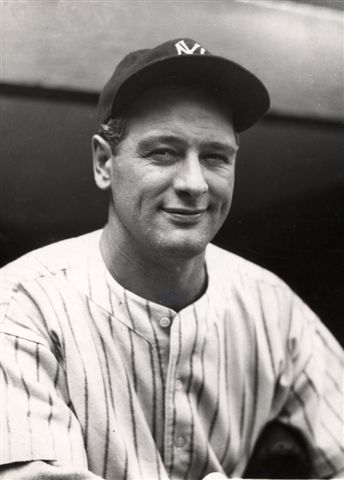Larrupin’ Lou Gehrig Bids the Fans Adieu in Kansas City
This article was written by Jack Kavanagh
This article was published in Road Trips: SABR Convention Journal Articles
This article was originally published in “Unions to Royals: The Story of Professional Baseball in Kansas City,” the 1996 SABR convention journal.
 There was no bounce in Lou Gehrig’s step as he walked into the depot dining room of Union Station in Kansas City. His roommate, Bill Dickey, carried two equipment bags, his and Lou’s. The World Champion New York Yankees were in town to play an exhibition game with their AAA farm team, the Kansas City Blues of the American Association. Back east, the new Baseball Hall of Fame was being dedicated in Cooperstown, N.Y. It was June 11, 1939.
There was no bounce in Lou Gehrig’s step as he walked into the depot dining room of Union Station in Kansas City. His roommate, Bill Dickey, carried two equipment bags, his and Lou’s. The World Champion New York Yankees were in town to play an exhibition game with their AAA farm team, the Kansas City Blues of the American Association. Back east, the new Baseball Hall of Fame was being dedicated in Cooperstown, N.Y. It was June 11, 1939.
During the night a westbound Union Pacific train had dropped the two Pullmans used by the Yankees on a siding. The team, sleepy-eyed and wearing rumpled suits, their manager insisted they must, would have breakfast in the depot dining room before riding cabs to the ball park for the sold-out game. When the game was over, only Lou Gehrig would check into a hotel after his teammates left. The next day Gehrig would take a train to Rochester, Minnesota, and visit the Mayo Clinic. Someone there might be able to tell him why, at 36, he felt like a man in his 60s.
The Yankees owners, taking advantage of an off day in the major league schedules for the Hall of Fame ceremony, had added this stop to their western swing. The day before they had brushed aside the last-place Browns twice before a sprinkling of depression-era fans in St. Louis. Today would be different. Over 20,000 tickets had been sold to fans eager to see the famous Yankees. The new star, Joe DiMaggio, would face off against his older brother, Vince, a center fielder like Joe. Vince was leading the American Association in batting and home runs. Local enthusiasts argued Vince was the best of the ball playing DiMaggio brothers.
The newspapers had warned that Lou Gehrig would not play. He had been missing from the Yankees lineup since May 2, when his consecutive game string had ended 2, 130 straight games. As the team’s captain, he traveled with the team, carrying the lineup cards to the umpires before each game, then returning to the dugout to puzzle over his lost strength and coordination.
Later that day, Lou Gehrig would explain to reporters, “I guess everybody wonders why I’m going to the Mayo Clinic. But I can’t help believe there’s something wrong with me. It’s not conceivable that I could go to pieces so suddenly. I feel fine, feel strong and have the urge to play, but without warning this year I’ve apparently collapsed. I’d like to play some more and I want somebody to tell me what’s wrong. Usually a fellow slows up gradually.”
When Gehrig handed the starting lineup card to the home plate umpire, surprisingly his name was on it. His replacement in the Yankee lineup, Babe Dahlgren, had been crossed out and Gehrig would bat eighth. He explained that as long as so many people had come to see him, he would try to play a few innings for them. He handled four putouts at first base and it was the third inning before Gehrig came to bat.
The wide stance in the left-handed batter’s box was familiar. Gehrig squared off the way he always had. The bat was held the same way. But the menace was gone. He made contact and the box score tells us that he grounded out, second to first. When the Yankees took the field again, Dahlgren was at first base. Larrupin’ Lou Gehrig had batted for the last time as a New York Yankee. He would never play the game of baseball again.
The fans got their money’s worth. The Yankees, winning 4-1, kept their stars, Gordon, Keller, Rolfe, Henrich, Crosetti on the field for six innings. Joe DiMaggio, with a bandaged right wrist, was hitless in three times at bat. His brother, Vince, singled in his three times up. Neither hit a home run. A brisk wind was blowing in on an otherwise ideal sunny June afternoon.
After the game the police had to rescue the Yankees from crowds of autograph seekers. Inside the clubhouse, the Blues’ youngest player, the future Yankee shortstop Phil Rizzuto, was a happy youngster gathering autographs for himself.
On July 4, after he had learned his fate from the Mayo Clinic, Lou Gehrig would make his formal farewell to the fans in special ceremonies at Yankee Stadium. The scene is familiar, both from the newsreels which show a tearful Gehrig saying, “Today, I’m the luckiest man on the face of the earth,” or Gary Cooper recreating the scene in the movie The Pride of the Yankees.
However, it was to a typical midwestern baseball crowd, few of whom had ever seen him play before, that the once-indestructible Iron Horse said his last goodbye as a player. The slugger called “Larrupin’ Lou” for the velocity of base hits crashing off his bat, had made one final, awkward appearance. The time left to Larrupin’ Lou was short. He died on June 2, 1941, not quite two years after his last ball field appearance, playing first base in the uniform of the Yankees in Kansas City, far from New York City and the Yankee Stadium.
Photo credit
Lou Gehrig, National Baseball Hall of Fame Library.


